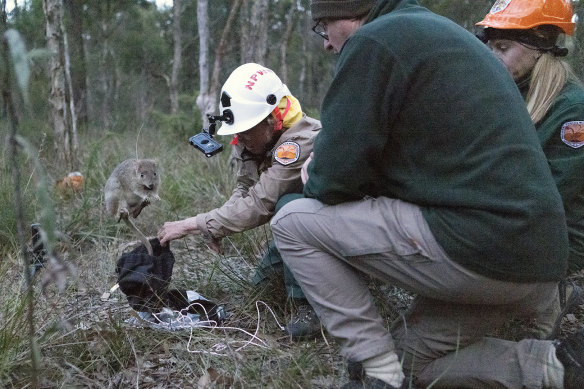Why this little digger’s return to Sydney is so important
By Laura Chung
The little eastern bettong jumps out of a green canvas bag held by a National Parks and Wildlife Service officer before it bounds off into the bush. It’s the first time this small hopping marsupial has been in the western Sydney national park for more than 100 years.
But the little rat kangaroo has a bigger role to play than just helping its species bounce back in the Yiraaldiya National Park. It’s known as an ecosystem engineer: through its digging, the bettong restores ecosystems by keeping soil healthy and helping seeds germinate.

Eastern bettongs have been released into Yiraaldiya National Park. The small marsupials last roamed the Australian mainland more than 100 years ago.Credit: NSW Government.
Foxes pushed bettongs to extinction on mainland Australia by the 1920s, with the last record of the marsupial recorded in 1906.
Yiraaldiya National Park, a 535-hectare area north-east of Penrith, is the only feral-free network within the region and will be used to reintroduce up to 30 species that were previously extinct from the area. As well as the eastern bettong, these include the eastern quoll – last seen in the 1960s in Vaucluse, the long-nosed bandicoot and the New Holland mouse.
A further 20 reptiles and amphibians which are locally extinct or close to it are being considered for reintroduction.
National Parks and Wildlife Service head Atticus Fleming said projects such as the one in Yiraaldiya were critical in buying conservationists more time to protect declining species populations while longer-term solutions were investigated. This includes ongoing management of invasive species, such as foxes and cats.
“This is important because Australia has the worst mammal extinction rate in the world. Australia is the global epicentre for mammal extinctions: cats, foxes and other ferals have unfortunately given us that legacy,” he said. “The bettong family is a good example of not enough focus on how important Australian fauna is and how big of a loss it is to the world if these species go extinct.
“Projects like these are starting to turn back the tide of extinction.”
Invasive Species Council advocacy manager Jack Gough said the best time to deal with invasive species was during El Nino events because, during warmer and drier months, invasive species tended to congregate around water sources and did not breed, allowing authorities an opportunity to manage numbers.
“We know that landscape-scale responses to the threats to our wildlife and ecosystems are needed if we are to step off the extinction train,” he said.
About 100 of Australia’s unique flora and fauna species have been wiped off the planet since colonisation, including 34 mammals. Foxes and cats were responsible for 25 of the native mammal extinctions. The rate of loss, which is as comprehensive as anywhere else on Earth, has not slowed over the past 200 years.
Research earlier this year found that roaming pet cats kill 546 million animals a year in Australia, 323 million of which are native animals.
Get to the heart of what’s happening with climate change and the environment. Our fortnightly Environment newsletter brings you the news, the issues and the solutions. Sign up here.